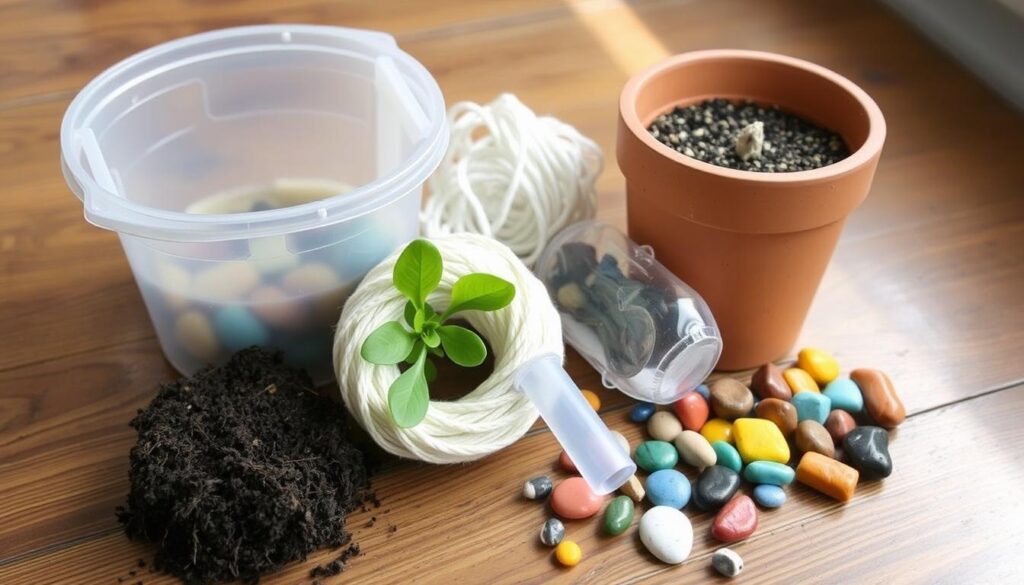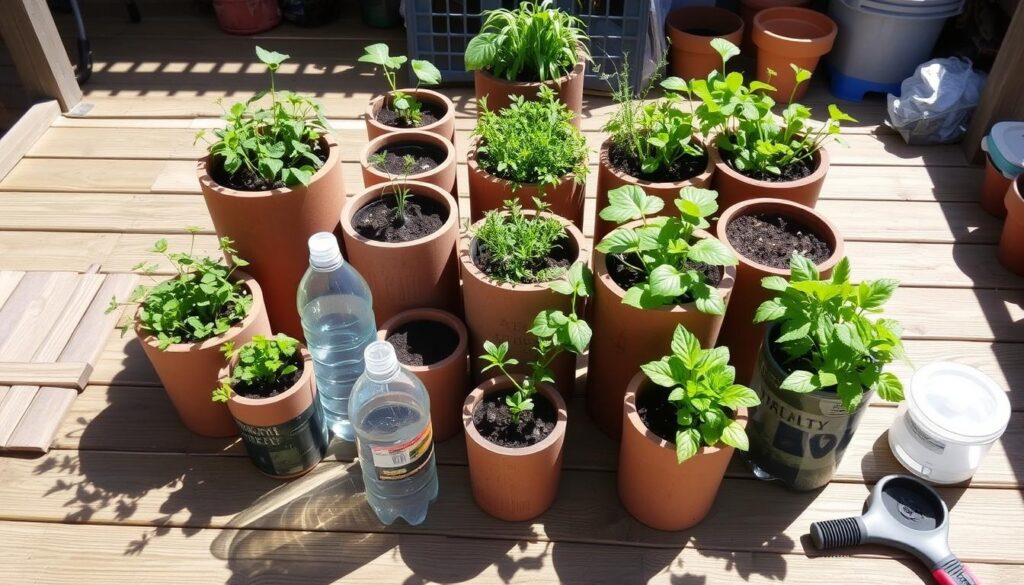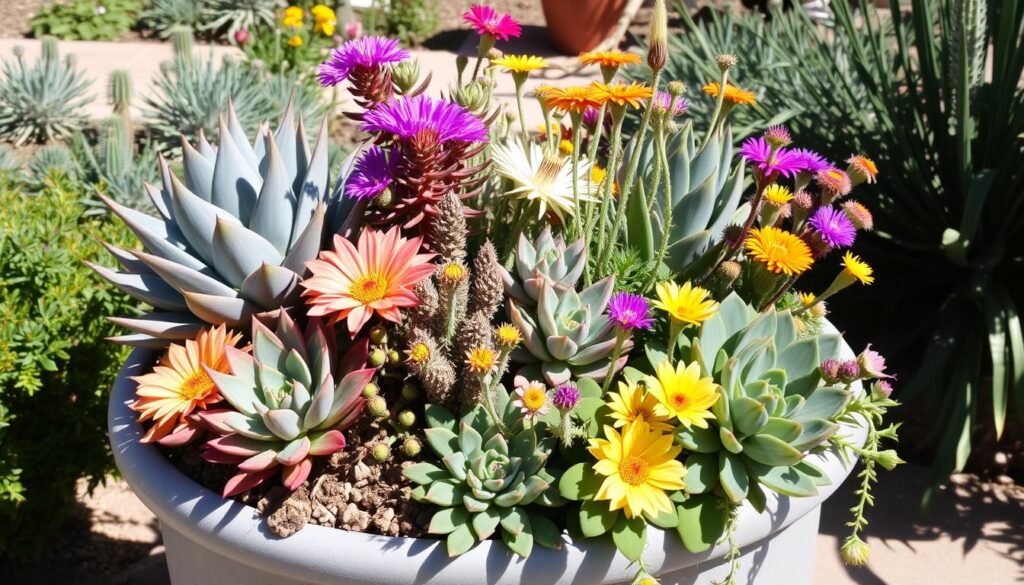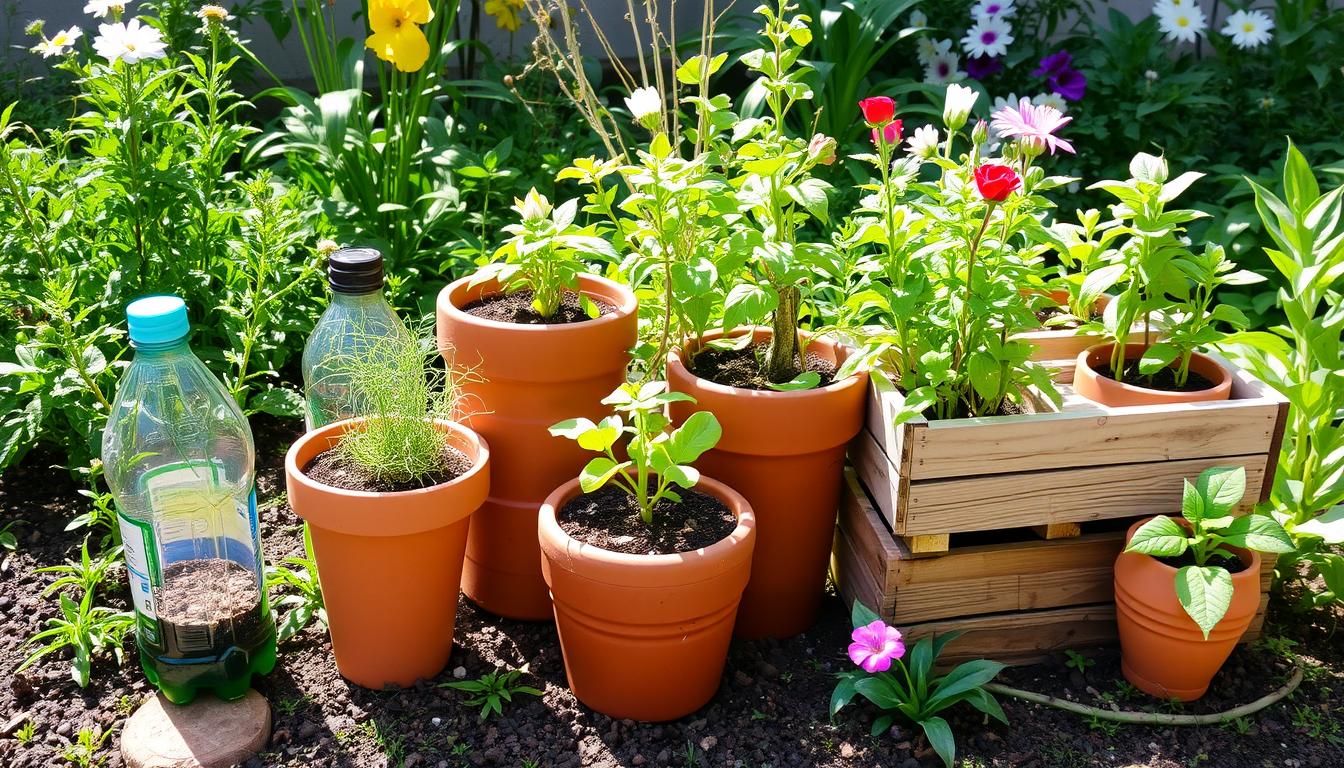As a gardener, I’ve faced the challenge of keeping plants watered, especially when I’m busy. That’s why I’m excited to share my DIY self-watering planters. They’re a game-changer for busy gardeners like me. These planters mix the perks of a raised garden bed with a smart watering system. This makes it simple to keep a garden healthy without constant care.
My DIY self-watering planters are not just useful but also look great. They have a sturdy, attractive design that fits any outdoor area. The raised bed offers 44×22 inches of space for gardening, with a 14-inch depth. This lets many plants grow well. The planter’s legs are designed to fit snugly in places like patios or driveways, ensuring it gets the most sunlight.
Key Takeaways
- DIY self-watering planters are a game-changing solution for busy gardeners
- Combines the benefits of a raised garden bed with a clever watering system
- Provides ample gardening space (44×22 inches) with a 14-inch depth
- Sturdy, furniture-like design with tapered legs for easy placement
- Allows for growing a wide variety of plants in any outdoor space
What Is a Self-Watering Planter?
A self-watering planter is a special container garden with a built-in water reservoir. This design keeps your plants moist, cutting down on watering needs. It’s perfect for those who are always busy or travel a lot, as it ensures plants stay watered even when it’s hot or dry.
Benefits of Self-Watering Planters
Self-watering planters are great for growing low-maintenance plants like drought-resistant plants, succulents, and herbs. They’re ideal for urban gardening and apartment gardening, where watering can be tough. With these planters, you can enjoy the perks of sustainable gardening without the constant watering hassle.
- Consistent moisture for your plants, preventing them from drying out
- Ideal for growing drought-resistant plants and succulents in urban or indoor settings
- Reduces the need for frequent watering, making them a great choice for busy gardeners or those who travel often
- Promotes healthier, stronger plant growth with an automated watering system
- Helps conserve water, supporting sustainable gardening practices
Whether you’re a seasoned gardener or new to container gardening, self-watering planters are a smart choice. They offer a low-maintenance way to grow a variety of plants at home or in the city. With their self-irrigating features, you can enjoy lush, thriving plants with little effort.
Materials and Tools Needed
Building a DIY self-watering planter is a great way to enjoy automated irrigation and water-saving planters. You’ll need some key materials and tools to start. Let’s look at what you’ll need for this fun project.
You’ll first need a plastic tote or container as the base of your planter. It will hold the water reservoir and support your plants. You’ll also need a 1-inch PVC pipe, a 1-inch PVC elbow fitting, and duct tape for the water system.
- Plastic tote or container
- 1-inch PVC pipe
- 1-inch PVC elbow fitting
- Duct tape
- Plastic baskets
- Zip ties
- Sharpie
For tools, you’ll need scissors, a hacksaw, a utility knife, and a drill. You’ll also need landscape fabric, an old garden hose or PVC pipe, empty water bottles, a small cup or bottle, an old long-sleeved shirt, and loose rock, gravel, or pebbles. These are for the wicking system and to keep the soil moist.
| Materials | Tools |
|---|---|
|
|
With these materials and tools, you’re ready to make a self-watering planter. It will use automated irrigation, water-efficient planters, and sustainable gardening. Now, you can start your urban farming or indoor gardening project!

DIY Self-Watering Planters for Busy Gardeners
Step-by-Step Instructions
Making your own DIY self-watering planters is a smart move for vertical gardening. It’s also a great way to start with gardening if you’re new. These planters help your indoor plants grow well with little work. Here’s how to make your own automated irrigation system for your self-care gardens.
- Begin by attaching a PVC pipe to the corner of a plastic tote with duct tape. This will be the water reservoir.
- Then, cut the tote’s lid to fit as the insert. This will keep the water and soil separate.
- Next, cut holes in the insert for the “feet” or “wicks” from plastic baskets. Use zip ties to hold them in place.
- Drill a hole in the tote’s side, just above the insert. This hole lets excess water drain.
- Fill the planter with soil, making sure the basket feet absorb water well.
For the second planter, I found starting with holes in the lid before cutting the insert saved time. These DIY planters are affordable and easy to make, unlike store-bought ones.

“These gardening hacks have been a game-changer for my green living journey. The self-watering planters have kept my indoor plants thriving with minimal effort, making them the perfect solution for my busy lifestyle.”
By following these steps, you can make your own DIY self-watering planters. They offer easy gardening solutions for your self-care gardens. Start these beginner-friendly projects and enhance your sustainable urban gardens.
Choosing Plants for Your Self-Watering Planter
When you’re setting up a self-sufficient garden, picking the right plants is key. Look for drought-resistant and water-efficient plants. These will do well in the moist soil of your self-watering planter.
Succulents, herbs, and leafy greens are great for self-watering planters. They like the moist soil, unlike plants that need dry spells. Some tomatoes and vine crops also work, especially the determinate types that won’t grow too big.
Choosing the right plants makes your garden easy to care for. You’ll save water and get a lot of harvest with little effort. These time-saving gardening solutions are ideal for those who are busy but still want to garden.

The secret to success with self-watering planters is picking plants that love moist soil. With the right drought-resistant plants, you’ll have a lush, self-sufficient garden. It will save resources and save you time in the garden.
Conclusion
DIY self-watering planters are great for busy gardeners. They make container gardening easy without the need for constant watering. These planters mix a raised garden bed with an automated watering system.
They keep your plants moist, even when you’re away. You can build your own using simple steps and common materials. This way, you can make a planter that fits your needs.
DIY self-watering planters are perfect for growing herbs, veggies, or flowers. They make gardening easy indoors or outdoors. These systems use indoor garden systems and automatic irrigation for sustainable horticulture and easy houseplant care.
They follow hydroponic gardening principles. This makes them a great gardening hack for all gardeners.
Building your own self-watering planter is rewarding. It lets you grow a healthy garden with little effort. With the right materials and creativity, you can make a planter that meets your needs.
Try DIY self-watering planters for a successful gardening experience. They offer a new way to enjoy gardening!
FAQ
Q: What is a self-watering planter?
A: A self-watering planter is a special container garden. It has a built-in water reservoir. This keeps plants moist, so you don’t have to water them as often.
Q: What are the benefits of a self-watering planter?
A: Self-watering planters are great for those who don’t have a lot of time to garden. They keep plants from drying out, even when it’s hot or dry. They’re perfect for growing plants that don’t need much water, like succulents and herbs, in places where it’s hard to water them.
Q: What materials and tools are needed to build a DIY self-watering planter?
A: To make a DIY self-watering planter, you’ll need a plastic tote or container. You’ll also need 1-inch PVC pipe, a PVC elbow fitting, duct tape, plastic baskets, zip ties, and a Sharpie. You’ll need scissors, a hacksaw, a utility knife, and a drill for tools. You’ll also need landscape fabric, old garden hose or PVC pipe, empty water bottles, a small cup or bottle, an old long-sleeved shirt, and loose rock, gravel, or pebbles.
Q: How do I build a DIY self-watering planter?
A: To build a DIY self-watering planter, start by attaching the PVC pipe to the tote’s corner with duct tape. Cut the tote’s lid to fit, creating a divider. Cut holes in the divider for the “feet” or “wicks” made from plastic baskets. Secure them with zip ties. Drill a hole in the tote’s side, just above the divider. Fill the planter with soil, packing it well into the basket feet.
Q: What types of plants work best in a self-watering planter?
A: Choose drought-tolerant and water-efficient plants for your self-watering planter. Succulents, herbs, leafy greens, and some tomatoes or vine crops are good choices. Avoid plants that need very dry soil between waterings, as the self-watering system will keep the soil moist.






